Australian metal 3D printer manufacturer SPEE3D has launched its new Expeditionary Manufacturing Unit (EMU), a mobile additive manufacturing system optimized for defense applications.
Combining the company’s XSPEE3D cold spray 3D printer and SPEE3Dcell post-processing unit, the EMU is designed to be deployed to remote locations. This enables military forces to rapidly produce metal spare parts where they are needed.
Speaking to 3D Printing Industry Calum Stewart, SPEE3D’s Director of Defense Programs, called EMU “a very unique and rare value proposition” due to its mobility, ruggedness, and ability to produce “parts of consequence” at speed.
He also explained how the EMU overcomes the biggest challenges currently faced by the defense industry and highlighted its ability to get “more equipment back in the fight more of the time.”
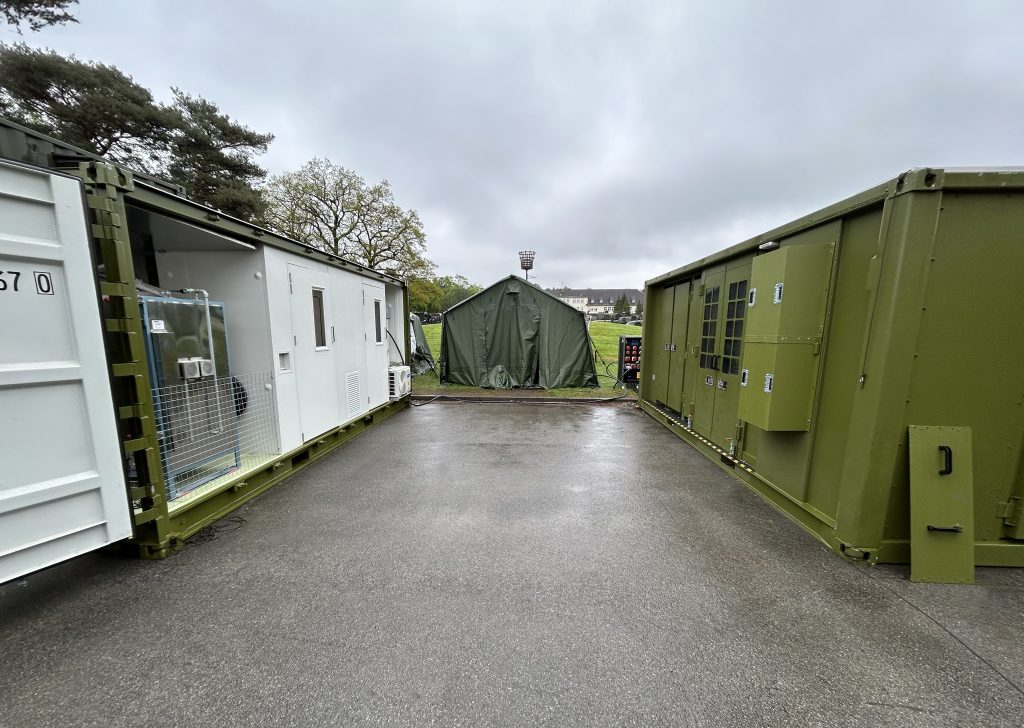
Overcoming supply chain challenges with SPEE3D’s EMU
Over recent years, notable threats to imports and global supply chains have emerged around the world. These include the COVID-19 pandemic, conflict in Ukraine, attacks on shipping in the Red Sea and Gulf of Aden, and growing tension in the Taiwan Strait and South China Sea.
This poses a significant problem for military forces that often require metal parts at short notice. “Supply chains in the military can be fraught. You need to provide parts that are manufactured in the home nation to your deployed forces anywhere in the world, and shipping lanes are pretty tight right now,” explained Stewart. “And so we ask ourselves, what if Defense didn’t always have to rely on the supply chain being on time all of the time? What if Defense could manufacture time-critical parts for themselves, as a sort of insurance policy? Would that be of value?”
According to Stewart, the answer is an overwhelming yes. He believes that it is vital for defense forces to be able to produce spare parts on-site, keeping essential equipment up and running. “Even if 5% of the parts are getting made in theater, that’s going to help get more equipment back in the fight, more of the time.”
SPEE3D’s new EMU is designed to offer these capabilities in a single place. The new solution combines the company’s Cold Spray Additive Manufacturing (CSAM) technology with a fully equipped post-processing and testing unit.
SPEE3D’s new offering has been developed through military trials with the US Navy and the Australian and British Army’s. Running since 2020, these trials have enabled SPEE3D to implement changes from feedback and direct experience of manufacturing in a military environment. “These deployments enable continual learning,” explained Stewart. “The opportunity for an SME, like SPEE3D, to participate in so many deployments really has afforded us the opportunity to optimize the capability offering, whilst simultaneously earning the trust of Defense.”
Building on this experience, the EMU has been designed to fit into two containers that can be shipped on a truck and trailer, ship, or plane. Therefore, the system can be transported to remote locations anywhere in the world, allowing high-density metal parts to be 3D printed in almost any environment. “Mobility is hugely important,” explained Stewart. “You can easily move the EMU to where it needs to be.”
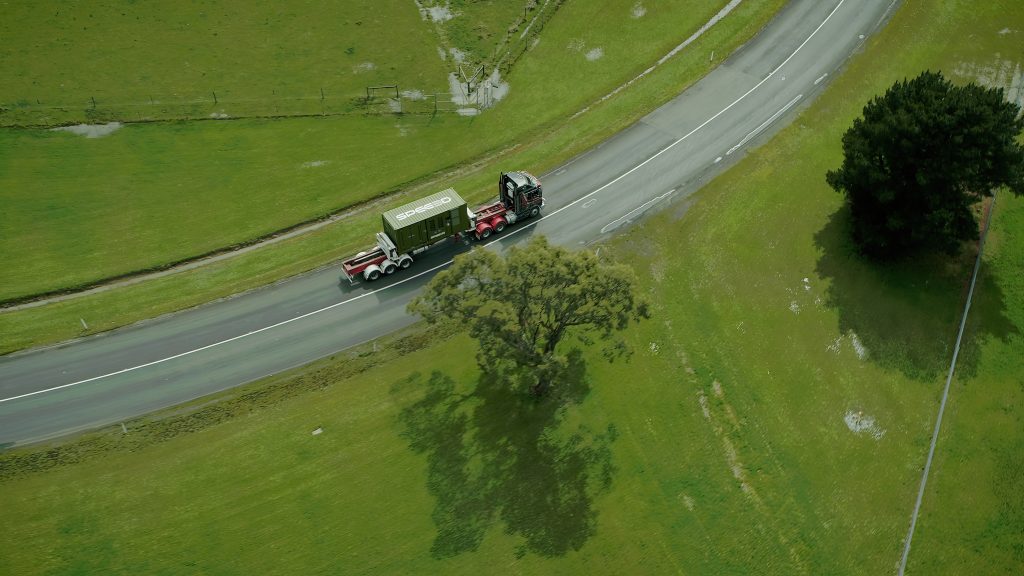
The EMU is optimized for the production of large-scale, metal sand casted-equivalent parts. “It can’t achieve the same level of intricate detail as a laser 3D printer. “We aren’t interested in manufacturing small and intricate titanium parts,” added Stewart. “The military isn’t asking for those. They want large metal parts and cast metal alloy parts, and the EMU offers the capabilities to achieve this.”
Indeed, SPEE3D’s technology has already been utilized to produce a range of large metal parts. These include parts for M113, CVRT, CRARRV, M777s, M109s, GWagons, Land Rovers and HIMARS.
While the EMU has been optimized to improve the warfighting capabilities of armies, its value is not limited to military applications. The system is ideal for customers who operate in remote environments and struggle to source large-scale metal parts due to supply chain weaknesses. “There are industries all over the world that are suffering from this, such as mining, oil and gas, and agriculture,” added Stewart.
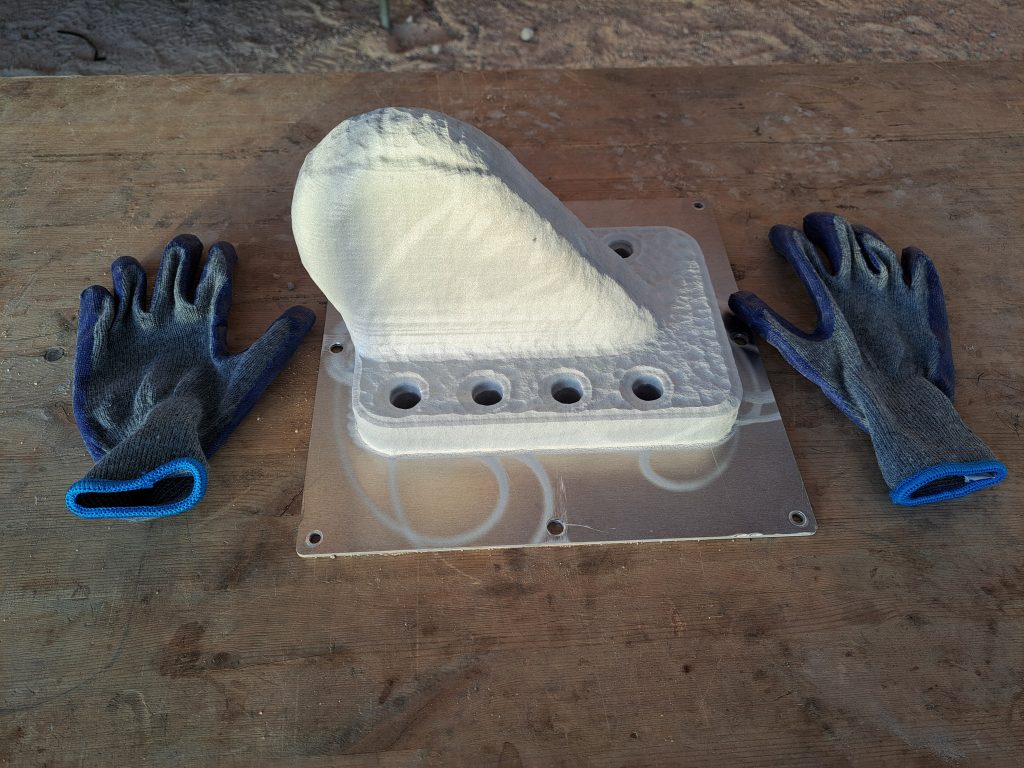
High-speed, large-scale metal 3D printing with XSPEE3D
The EMU incorporates an XSPEE3D metal 3D printer. This system allows parts measuring ⌀0.9m x 0.7m and weighing up to 40kg to be fabricated in aluminum, aluminum bronze, stainless steel, and copper with new maritime-specific materials being released next month. The XSPEE3D is optimized for efficient and high-capacity metal 3D printing in remote environments.
The 3D printer is powered by SPEE3D’s CSAM cold spray technology. Unlike conventional metal 3D printers that produce parts by fusing powder with lasers, this technology sprays metal particles at supersonic speeds onto a substrate. The sheer force of the kinetic energy causes the particles to bind together, creating strong parts with low porosity and predictable material properties.
A key draw of this technology is its speed. Thanks to CSAM, the XSPEE3D can achieve build rates of up to 100g per minute. “We are not melting material, which allows us to make parts really quickly,” explained Stewart. “Large metal parts that would take days or weeks to 3D print on laser-based systems can be produced in a matter of hours.”
Unlike other metal 3D printers, SPEE3D’s technology does not feature any lasers or inert gases which can take weeks to prepare and calibrate. As such, the XSPEE3D heats up and is ready for 3D printing in just seven minutes. This is ideal for defense applications that require high-volume production of metal parts at short notice.
Stewart also pointed to the XSPEE3D’s ruggedized design, which ensures that it can be transported and deployed in challenging environments without being damaged. “There are no lasers so it’s not fragile. Cold Spray just moves metal powder really quickly, making it really robust.”

The 3D printer is powered by SPEE3D’s TwinSPEE3D software, which can automatically process 3D print files and generate optimal tool paths. “Military personnel generally say it is the best 3D printing software out there,” stated Stewart. “Soldiers love it because it’s easy and intuitive.”
Once a tool path simulation has been created, it can be reviewed and modified before 3D printing begins. TwinSPEE3D highlights exactly where the design will succeed, and if it will fail during the 3D printing process. This allows users to prevent failed 3D prints before they occur, saving time and material.
Once perfected, the tool path can be stored in the 3D printer’s library for future use, cutting down on print preparation time and streamlining the manufacturing process. This automation also guarantees reliable and repeatable results, ensuring parts are 3D printed correctly at the first time of asking. According to Stewart, “There’s nothing like TwinSPEE3D in the cold spray industry – a software that not only automatically generates a toolpath for you but also demonstrates a digital simulation.”
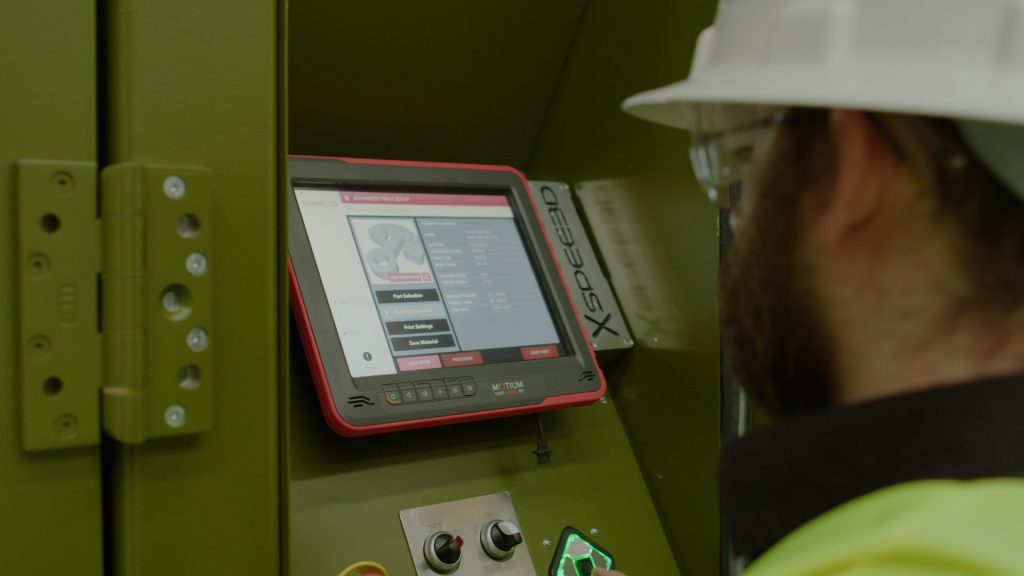
SPEE3Dcell: heat treatment, machining and testing in one place
SPEE3D’s SPEE3Dcell unit is also incorporated as part of the EMU. This fully equipped mobile post-processing shop includes heat treatment furnaces, a CNC three-axis mill, tooling, and testing equipment. According to Stewart, the system is easy to use and optimized for the production of military-grade parts.
Heat treatment is essential for the production of metal parts that possess good mechanical properties, are strong, and can be machined after 3D printing. The SPEE3Dcell features sintering and aging furnaces, with SPEE3D also providing optimized heat treatment recipes.
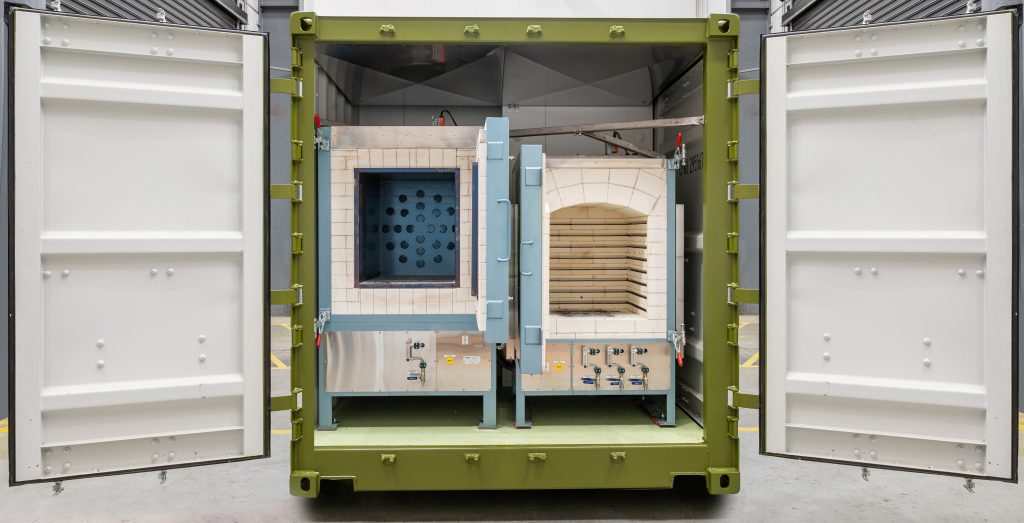
“It’s really simple,” added Stewart. “You just need to set the timer, programme the furnace and it’s going to do its job. At the end, you can bring it out, quench it, and you now have a part that you can machine with the CNC mill.”
Hardness, powder and load testing equipment are also included with the SPEE3Dcell. With the data that this testing equipment provides, users are able to produce a technical risk assessment while making a part, ensuring that it is suitable and safe for its intended use.
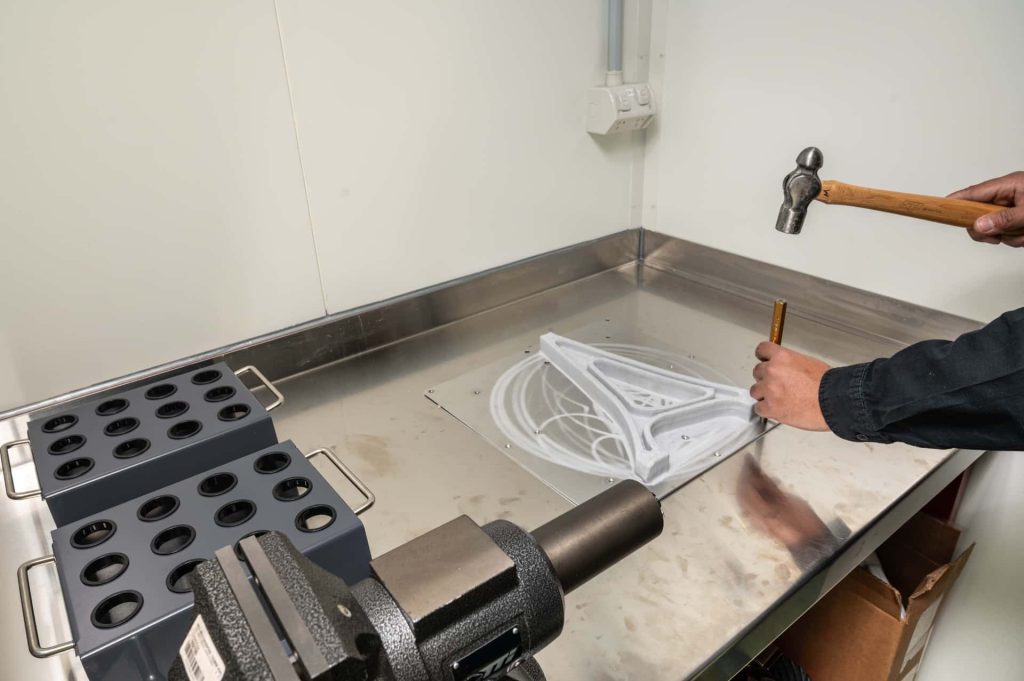
Technical Specifications
| Container 1: XSPEE3D (CSAM Metal 3D Printer) | |
| Maximum Part Size | Ø0.9m x 0.7m/ (Ø35” x 30”) |
| Maximum Part Weight | 40kg (88lbs) |
| Deposition Spot Size | 6mm (.24”) |
| Deposition Rate | Up to 100g (3.5oz)/minute |
| Electrical Power Supply | 400V I 3 Phase I 50/60Hz I 50kVA |
| Noise | <80dBA @ 1m |
| Footprint | 20ft container (doors closed): 6.2m(L) x 2.6m(W) x 2.6m(H) [20ft(L) x 9ft(W) x 9ft(H)] (approx.) |
| XSPEE3D Weight | 9980kg (22000lbs) |
| Software | TwinSPEE3D automation software: processes geometries and generates print paths |
| Software CAD Input | STL & STEP format |
| Container 2: SPEE3Dcell (Mobile Post-processing Unit) | |
| Dimensions | 20’(L) x 9’(W) x 9’(H) [6.2m(L) x 2.6m(W) x 2.6m(H)] |
| SPEE3Dcell Weight | < 8 tonnes |
| Power Input | 400V I 3 Phase I 50/60Hz I 50kVA |
| Furnace, CNC and Testing Equipment | 3-axis CNC Machine Sintering Furnace Aging Furnace Hardness Tester Metrology Equipment |
| Manual Equipment | Workbench incorporating tool storage Pedestal Drill (1.5kW) Grinder and LinisherVice Air Compressor (20 liter) Quench Tank |
Want to help select the winners of the 2024 3D Printing Industry Awards? Join the Expert Committee today.
What does the future of 3D printing hold?
What near-term 3D printing trends have been highlighted by industry experts?
Subscribe to the 3D Printing Industry newsletter to keep up to date with the latest 3D printing news.
You can also follow us on Twitter, like our Facebook page, and subscribe to the 3D Printing Industry Youtube channel to access more exclusive content.
Featured image shows the XSPEE3D cold spray additive manufacturing printer. Photo via SPEE3D.


